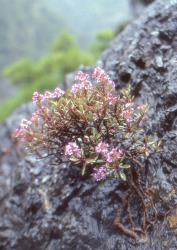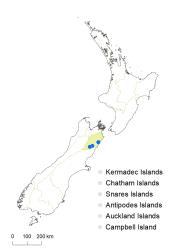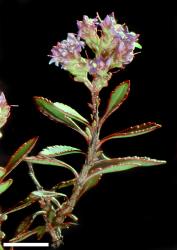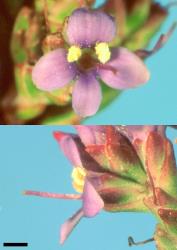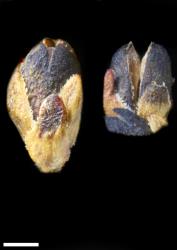- ≡ Heliohebe acuta Garn.-Jones, New Zealand J. Bot. 31: 326 (1993)
Sub-shrub or low shrub to 0.2 m tall. Stems ascending to erect eglandular-pubescent; hairs bifarious or uniform, short, recurved. Leaf bud indistinct; leaves separating while very small, opposite-decussate, erecto-patent; lamina coriaceous and rigid, lanceolate to oblanceolate, 5–15 mm long, 2–6 mm wide, dull green to bronze-green above, pale green beneath; midrib evident; surfaces glabrous except for minute glandular hairs along midrib above; margin glabrous, serrate; teeth in 3–8 pairs; apex acute; base cuneate; petiole 1–5 mm long. Inflorescence a terminal, compound raceme or spike, 10–20 mm long; flowers crowded, 30–70, all bisexual; bracts opposite-decussate, deltoid, > pedicels; pedicels erecto-patent, 0–0.2 mm long, eglandular-hairy all around. Calyx lobes 4, sub-acute to obtuse, 2.0–2.5 mm long, unequal, glandular- and eglandular-ciliate. Corolla 4–5 mm diameter; tube pink and greenish, 1.8–2.0 mm long, < calyx, glabrous; lobes 4, pink, sometimes dark or purplish-pink, erect (posterior) or spreading to recurved (lateral and anterior), sub-equal, elliptic to ovate, 2.0–2.5 mm long, sub-acute to obtuse; nectar guides absent. Stamen filaments pink to purplish, 1.0–1.2 mm long; anthers pale yellow. Style glabrous, 3.0–3.8 mm long. Capsules turgid, truncate to emarginate, glabrous, 2.0–2.5 mm long, 1.5 mm at widest point. Seeds narrowly obovoid, barely flattened, smooth, brown, 0.7–1.2 mm long.
V. scrupea plants are similar to plants of V. raoulii, also in the sun hebe group, but differ by their accumulation of corky bark, narrow acute leaves somewhat longitudinally folded along the midrib, stem hairs recurved but not appressed, smaller and bright pink to purplish flowers with four free calyx lobes, and coloured, shorter stamen filaments and styles with the stigma not or barely peeping from the bud before opening.
Unidentified plants collected from the Omaka River and Black Birch Creek, Marlborough (e.g., CHR 470178) resemble V. pentasepala in their erect habit and narrow leaves, but are more like V. hulkeana in their pale lilac flowers and four free calyx lobes, and like V. scrupea in their four free calyx lobes and narrow leaves that are sometimes acute.
South Island: Marlborough (Seaward Kaikōura Range, particularly in the Clarence River catchment at George Stream, Palmer Stream, Hossack Station). There are reliable but unvouchered reports from Alfred Stream, Gore Stream, and The Fell, and a photographic record from the shearwater colony high on the Seaward Kaikōura Range.
V. scrupea grows on cliffs and outcrops of shattered argillite, a habitat that is extensive in the area but inaccessible for botanical survey. Recorded elevations range from 338 to 822 m, but there is a photographic record at higher elevation.
V. scrupea grows together with V. raoulii and V. hulkeana, but no hybrids have been observed.
Flowers: October–November; fruits: January (persisting longer).
2n = 42 (M.I. Dawson in Garnock-Jones 1993; Dawson & Beuzenberg 2000, New Zealand Journal of Botany 38: 8) as Heliohebe acuta.
Veronica scrupea is classified in V. subg. Pseudoveronica sect. Hebe and informally in the “sun hebe” group (Albach & Meudt 2010). DNA sequences suggest a relationship to V. hulkeana (ITS data) and V. pentasepala (cpDNA data).



